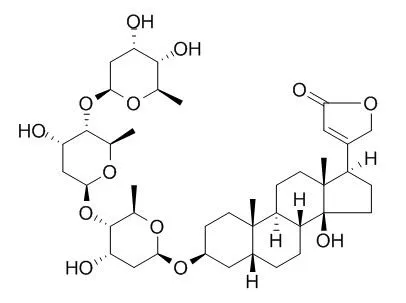| Description: |
The cardiac glycosides digitoxin and digoxin have been used in cardiac diseases for many years, digitoxin also has growth inhibition activity in three human cancer cell line, digitoxin activates pro-apoptotic, anti-proliferative signaling cascades and cell cycle arrest. Digitoxin could as a candidate drug for suppressing IL-8-dependent lung inflammation in cystic fibrosis (CF), it can suppress hypersecretion of IL-8 from cultured cystic fibrosis (CF) lung epithelial cells, the specific mechanism is to block phosphorylation of the inhibitor of NF-kappa.Digitoxin actively inhibits Herpes simplex virus type 1 (HSV-1) replication with a 50% effective concentration (EC(50)) of 0.05 microM, the inhibitory effects of digitoxin are likely to be introduced at the early stage of HSV-1 replication and the virus release stage. |
| In vitro: |
| Anticancer Drugs. 2014 Jan;25(1):44-52. | | Digitoxin sensitizes glioma cells to TRAIL-mediated apoptosis by upregulation of death receptor 5 and downregulation of survivin.[Pubmed: 24045365] | Glioblastoma multiforme is the most lethal and aggressive astrocytoma among primary brain tumors in adults. However, most glioblastoma cells have been reported to be resistant to tumor necrosis factor-related apoptosis-inducing ligand (TRAIL)-induced apoptosis.
METHODS AND RESULTS:
Here, we have shown that Digitoxin (DT), a clinically approved cardiac glycoside for heart failure, can induce TRAIL-mediated apoptosis of glioblastoma cells. DT in noncytotoxic doses (20 nmol/l) can increase TRAIL-induced apoptosis in TRAIL-resistant U87MG glioblastoma cells. Treatment with DT led to apoptosis and a robust reduction in the levels of the antiapoptotic protein survivin by inducing its proteasomal degradation; however, it did not affect the levels of many other apoptosis regulators. Moreover, silencing survivin with small interfering RNAs sensitized glioma cells to TRAIL-induced apoptosis, underscoring the functional role of survivin depletion in the TRAIL-sensitizing actions of DT.
CONCLUSIONS:
We demonstrate that inactivation of survivin and death receptor 5 expression by DT is sufficient to restore TRAIL sensitivity in resistant glioma cells. Our results suggest that combining DT with TRAIL treatments may be useful in the treatment of TRAIL-resistant glioma cells. | | Toxicol Appl Pharmacol. 2012 Jan 1;258(1):51-60. | | Digitoxin and a synthetic monosaccharide analog inhibit cell viability in lung cancer cells.[Pubmed: 22037315] | Mechanisms of Digitoxin-inhibited cell growth and induced apoptosis in human non-small cell lung cancer (NCI-H460) cells remain unclear. Understanding how Digitoxin or derivate analogs induce their cytotoxic effect below therapeutically relevant concentrations will help in designing and developing novel, safer and more effective anti-cancer drugs.
METHODS AND RESULTS:
In this study, NCI-H460 cells were treated with Digitoxin and a synthetic analog D6-MA to determine their anti-cancer activity. Different concentrations of Digitoxin and D6-MA were used and the subsequent changes in cell morphology, viability, cell cycle, and protein expressions were determined. Digitoxin and D6-MA induced dose-dependent apoptotic morphologic changes in NCI-H460 cells via caspase-9 cleavage, with D6-MA possessing 5-fold greater potency than Digitoxin. In comparison, non-tumorigenic immortalized bronchial and small airway epithelial cells displayed significantly less apoptotic sensitivity compared to NCI-H460 cells suggesting that both Digitoxin and D6-MA were selective for NSCLC. Furthermore, NCI-H460 cells arrested in G(2)/M phase following Digitoxin and D6-MA treatment. Post-treatment evaluation of key G2/M checkpoint regulatory proteins identified down-regulation of cyclin B1/cdc2 complex and survivin. Additionally, Chk1/2 and p53 related proteins experienced down-regulation suggesting a p53-independent cell cycle arrest mechanism.
CONCLUSIONS:
In summary, Digitoxin and D6-MA exert anti-cancer effects on NCI-H460 cells through apoptosis or cell cycle arrest, with D6-MA showing at least 5-fold greater potency relative to Digitoxin. | | Antiviral Res. 2008 Jul;79(1):62-70. | | Anti-HSV activity of digitoxin and its possible mechanisms.[Pubmed: 18353452 ] | Herpes simplex virus type 1 (HSV-1) can establish latent infection in the nervous system and usually leads to life-threatening diseases in immunocompromised individuals upon reactivation. Treatment with conventional nucleoside analogue such as acyclovir is effective in most cases, but drug-resistance may arise due to prolonged treatment in immunocompromised individuals.
METHODS AND RESULTS:
In this study, we identified an in-use medication, Digitoxin, which actively inhibited HSV-1 replication with a 50% effective concentration (EC(50)) of 0.05 microM. The 50% cytotoxicity concentration (CC(50)) of Digitoxin is 10.66 microM and the derived selective index is 213. Several structural analogues of Digitoxin such as digoxin, ouabain octahydrate and G-strophanthin also showed anti-HSV activity. The inhibitory effects of Digitoxin are likely to be introduced at the early stage of HSV-1 replication and the virus release stage.
CONCLUSIONS:
The observation that Digitoxin can inhibit acyclovir-resistant viruses further implicates that Digitoxin represents a novel drug class with distinct antiviral mechanisms from traditional drugs. |
|






 Cell. 2018 Jan 11;172(1-2):249-261.e12. doi: 10.1016/j.cell.2017.12.019.IF=36.216(2019)
Cell. 2018 Jan 11;172(1-2):249-261.e12. doi: 10.1016/j.cell.2017.12.019.IF=36.216(2019) Cell Metab. 2020 Mar 3;31(3):534-548.e5. doi: 10.1016/j.cmet.2020.01.002.IF=22.415(2019)
Cell Metab. 2020 Mar 3;31(3):534-548.e5. doi: 10.1016/j.cmet.2020.01.002.IF=22.415(2019) Mol Cell. 2017 Nov 16;68(4):673-685.e6. doi: 10.1016/j.molcel.2017.10.022.IF=14.548(2019)
Mol Cell. 2017 Nov 16;68(4):673-685.e6. doi: 10.1016/j.molcel.2017.10.022.IF=14.548(2019)